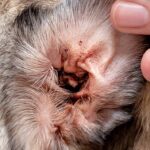
This article was updated on May 1st, 2023

As pet owners, we want our dogs to be healthy from head to toe. But one area that often gets overlooked is the ears. In fact, according to the American Kennel Club, a whopping 20% of dogs will develop an ear infection at some point in their lives. That’s a huge number! In this article, we will review the differences between dog yeast ear infections and dog ear mites (with pictures) and give advice from our veterinary team on what to do.
Ear yeast infections and ear mites can be itchy, painful, and costly. Left untreated, both conditions could potentially worsen, resulting in high veterinary bills for you and prolonged discomfort for your pooch.
Thankfully, with a little education, all dog owners can learn how to prevent, spot, and treat dog ear yeast infections and ear mites.
Is Your Dog More Likely to Have an Ear Yeast Infection or Ear Mites?
If you are not sure between the two, chances are that your dog has an ear yeast infection, as they are much more common. Our veterinarian, Dr. Sara Ochoa shares: “Ear mites are not common ear issues in dogs. I see maybe 2 dogs a year with ear mites. These are usually puppies that come from a shelter. Bacterial and yeast infections in dogs ears are much more common. I see at least 5 dogs a day with an ear infection that is bacterial, yeast, and many times both.” Read our articles about:
- Dog Yeast Ear Infections – With Pictures & Veterinarian Advice
- 5 Most Common Dog Ear Infections [with images] & What To Do
How To Tell The Difference Between a Yeast Infection and Ear Mites
Yeast infections have specific “giveaway” symptoms. These include:
- Itching / Scratching
- Head Tilt
- Red, yellow, or brown wax discharge
- Loss of Balance
- Red skin around the ear
- A distinctly “cheesy” smell

On the other hand, ear mites appear differently. These tiny parasites go by the scientific name Otodectes cynotis. They are 1-2 millimeters in size, just large enough to be seen with a microscope, and look somewhat like a tick. And just like a tick, they feed on your dog’s blood, ear wax, and oils…Gross!
Ear mite symptoms include:
- Itching / Scratching
- Head Tilt
- Scabs
- Skin inflammation
- Black crusty debris in the ears

How to Tell the Difference Between Ear Yeast Infections and Ear Mites: Our Veterinarians Explain
As you can see, both dog ear yeast infections and ear mites have many similar symptoms. But there are major differences. Let’s review. A dog ear yeast infection is a fungus. In contrast, ear mites are parasites. –
- Generally speaking, ear mites are itchier than yeast infections.
- With an ear yeast infection, an odor will be noticeable, whereas with mites, your nose might not be able to smell anything at all.
- But the #1 way to tell the difference is this: ear mites produce dark red, brown, or black crumbly substances. Sort of like coffee grounds. See dark matter falling out of their ears? It may be mites. Keep in mind; however, that yeast ear infections also produce a black, crumbly substance, and ear mites are uncommon in dogs.
- Mites are contagious, so your dog has to have a history of close contact with an infected animal.
This discharge seen in mites is a combination of dried blood (from all that scratching), wax, debris, and those nasty little mites. Yeast infections in your dog’s ear can also look black or brown but will have a creamier texture.
The only way to definitively tell if your dog has ear mites or a yeast infection is to look at an ear swab under the microscope. While many people do not have a microscope at their house, this is where your vet will come in to help. They can easily see ear mites under the microscope and be able to tell you the cause of your dog’s ear issues.
How to Help a Dog with an Ear Yeast Infection
To treat your dog, there are several options. Dogs with a yeast infection in their ears will need an antifungal ear cleaner or medication. This is typically topical, meaning it’s applied directly onto the affected skin area.
As you are waiting to see the vet, you may want to use an OC non-medicated cleaner to relieve some discomfort. The cleaner must be non-medicated at this point since your vet has not done an exam yet. Your vet needs to ensure the eardrum is intact before starting ear medications or medicated cleaners; if the eardrum is ruptured, certain medications can even cause deafness.
How to Help a Dog with Ear Mites
Because ear mites are so rare in dogs, it is important to get a diagnosis before putting antiparasiticides into the ear. These medications can cause serious issues if administered to a dog that actually has an ear infection.
Read more tips on our page about dog ear infections.
Final Thoughts
In summary, both dog ear yeast infections and ear mites are possible causes of an itchy ear, but mites are much less common. To minimize the likelihood of either, clean your dog’s ear canals and inner flaps regularly using a safe and non-toxic ear cleaner. And remember, always consult your veterinarian before giving your dog any treatment. Doing so will ensure your pup’s ears stay clean and healthy!
Disclaimer: This website's content is not a substitute for veterinary care. Always consult with your veterinarian for healthcare decisions. Read More.






Be the first to comment